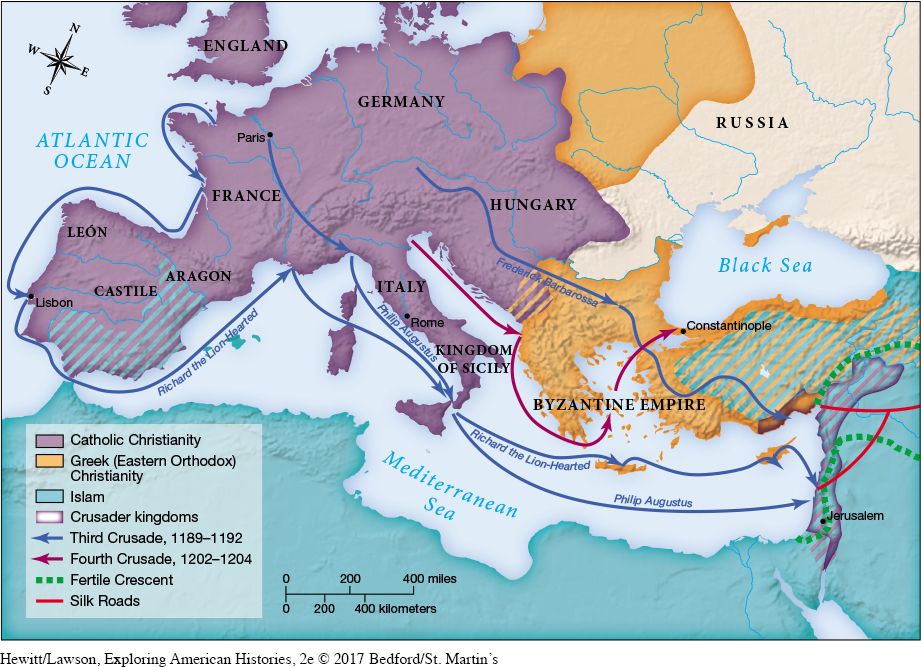The Mediterranean World
Beginning in the seventh century Islam proved one of the most dynamic cultural, political, and military forces in the world. By the ninth century, Islamic (also known as Muslim) regimes created an Arab empire that controlled most of southwest Asia and North Africa and conquered parts of the Iberian peninsula in Europe (Map 1.3). In the eleventh and twelfth centuries, Catholic leaders launched several military and religious campaigns to reclaim Jerusalem and other sites associated with Jesus for the church. Later known as the Crusades, these campaigns largely failed, but they enhanced the roles of Italian merchants, who profited from both outfitting Crusaders and opening new trade routes to the East. Moreover, these campaigns inspired explorers and adventurers throughout Europe.

Europeans also learned of successful civilizations in the Middle East, where inhabitants had managed to survive droughts and other ecological crises, largely because of their productive economic systems. In the Mediterranean world, this productivity depended on technological advances in irrigation and navigation and a vast network of slave-trading centers and enslaved laborers. It was the productivity of agriculture—developed centuries earlier than in Europe or America—that allowed societies along the southern Mediterranean, in northern Africa, and in southwest Asia to excel in astronomy, mathematics, architecture, and the arts.
Medieval European states proved far less adept at staving off human and environmental disasters than their counterparts to the south. Besieged by drought and disease as well as wars and peasant rebellions, rulers across the continent expended most of their resources on trying to sustain their population and protect their borders. In the 1340s, as Europeans began to trade with various regions of Asia, fleas on rats carried the bubonic plague and similar epidemic diseases on board ships and into European seaports. From the 1340s to the early fifteenth century, the plague—later called the Black Death—periodically ravaged European cities and towns. During the initial outbreak between 1346 and 1350, about 36 million people—half of Europe’s population—perished. At the same time, France and England engaged in a century-long war that added to the death and destruction.
By the early fifteenth century, the plague had retreated from much of Europe, and the climate had improved. Only then were European peoples able to benefit significantly from the riches of the East. Smaller populations led to an improved standard of living. Then rising birthrates and increased productivity, beginning in Italian city-states, fueled a resurgence of trade with other parts of the world. The profits from agriculture and commerce allowed the wealthy and powerful to begin investing in the arts and luxury goods. Indeed, a cultural Renaissance (from the French word for “rebirth”) flourished in the Italian city-states and then spread to France, Spain, the Low Countries, and central Europe.
The cultural rebirth went hand in hand with political unification as more powerful rulers extended their control over smaller city-states and principalities. A vibrant and religiously tolerant culture had existed in Muslim Spain from the eighth to the tenth century, but that was followed by a long period of persecution of Christians. When Christians began reconquering Spain after 1200, Muslims and Jews alike became targets. Then in 1469, the marriage of Isabella of Castile and Ferdinand II of Aragon sealed the unification of Christian Spain. By 1492 their combined forces expelled the last Muslim conquerors from the Iberian peninsula. Promoting Catholicism to create a more unified national identity, Isabella and Ferdinand launched an Inquisition against supposed heretics and executed or expelled some 200,000 Jews as well. Despite the brutality of the reconquest and the Inquisition, Catholic Spain had the wealth and military power to forge its own trade networks with North Africa, India, and other Asian lands.

Explore
For one cartographer’s vision of the world during this period, see Document 1.1.
Yet Italy controlled the most important routes through the Mediterranean, so leaders in Spain and neighboring Portugal sought alternate paths to riches. Their efforts were aided by explorers, missionaries, and merchants who traveled to Morocco, Turkey, India, and other distant lands. They brought back trade goods and knowledge of astronomy, shipbuilding, mapmaking, and navigation that allowed Iberians to venture farther south along the Atlantic coast of Africa and, eventually, west into the uncharted Atlantic Ocean.
Exploring American HistoriesPrinted Page 10
Exploring American Histories Value EditionPrinted Page 9
Chapter Timeline